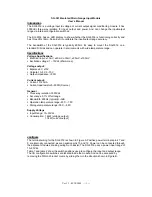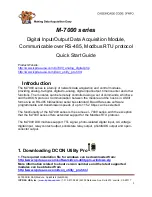
Pulse Instruments
System 4 Manual
Version 1.6
Visit us Online at
www.pulseinstrument.com
4
Process Meters:
Used in a fixed location for continuous monitoring of ORP and provides a highly reliable
up to date measurement as conditions continuously change in most process water applications. These
instruments may also be used as a source of reading only and manually dosing chemicals, however
continuous monitoring instruments are commonly used to automatically inject sanitizer on demand, and
provide a reliable method of process control as well as recording for automated record keeping.
Maintenance:
All ORP and pH electrodes need periodic maintenance and cleaning. A simple cleaning
procedure is dipping the electrode tip in dilute (1:100) acidic solution for two minutes and rinsing with
clean water. Then dip in electrode checking solution to verify accurate readings. Many ORP meters allow
calibration adjustment and should be corrected weekly. Inaccurate ORP readings are usually a result of
electrode contamination, which may be corrected by cleaning, or depletion of useful life, which needs
electrode replacement. Some ORP meters allow slight slope offset adjustments (calibration) to correct for
these errors.
pH measurement that follows a logarithmic curve requires more calibration adjustments than ORP that
follows a linear relationship. Both pH and ORP instruments should be calibrated regularly for reliable
accurate measurements, and routine periodic electrode maintenance should be performed.
Conclusion:
ORP has proven to be a reliable method of measuring water disinfection and provides the
operator with a single value of measurement regardless of which product, commodity, operation,
treatment or sanitizer is used, and regardless of varying field conditions or method by which chemical is
applied.
Fresh fruit and vegetable harvesting, post-harvest handling and cooling, packing and processing activities
that involve the use of water have a higher potential of contamination by plant pathogens and microbes.
Small errors in contamination prevention and water disinfection procedures can have severe
consequences due to the ease of spread of microbes, particularly in re-circulated water systems.
Accurate monitoring and recording of disinfection procedures is an important component of a sound post-
harvest quality and safety program.
The purpose of this manual is to provide users instructions on how to operate the water disinfection
system and a brief overview of the application of ORP monitoring to post-harvest sanitation processes.
1.2 Features
This dual pH and ORP control system is housed in a NEMA 4X weatherproof enclosure, which is an
essential HACCP tool. It includes a programmable logic controller (PLC) unit that controls alarm and
safety shut down. The audio alarm outputs 80 decibel with beacon and horn, and the safety shut down
automatically turns off the chemical pumps to prevent any hazardous condition. This simple modular
design offers affordable continuous monitoring and control, which allows unique hands free operation and
future upgrade capability for recording.
•
Works with any oxidizer
•
Sensors monitor pH and ORP
•
Controller automatically turns chemical pump On or Off as needed
•
Always maintain a tight chemical concentration range
•
Inject chemical only as needed
•
Self maintains and adjusts to organic load
•
Smart logic allows “Hands Free” Operation
•
Self-cleaning sensors allow low maintenance









































